Recently, NKB was called by an existing client to assist them with a problem they began experiencing with ice falling from window sills several stories above the ground. In mid-January, Old Man Winter comes to Upstate New York and dropped 14 inches of snow in about 36 hours. Temperatures ranged from 15ºF to 25ºF and wind speeds were consistently between 5 and 15 mph with occasional gusts of up to 35-40mph. Over the two days which followed the completion of the storm there were reports of ice buildup and falling to grade below. The client called us in to examine what might be causing the ice build-up. What we found when we walked the perimeter of the building and looked out on various façades of the building from facing windows was very telling.
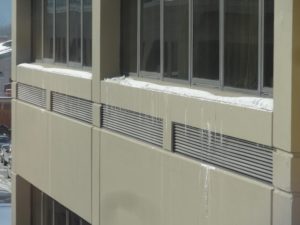
Melting at Window Sills
Each window sill showed some snow and ice still in place near the edge of the sill. The 6-8 inches nearest to the window was clear in all locations. Every – Single – Window. All 245 instances, showed the same clear area adjacent to the windows with ice buildup at the edge. Our client admitted that they did not recall if this was a problem prior to the façade renovation project. It had been several years since pedestrians were allowed anywhere near the building so there was no institutional memory of occurrences like this happening previously.
We began running through the list of things that could possibly cause this melting condition:
1. The windows are known to be headaches to the building management. Infiltration problems are known to exist so could we be getting warm air leakage at the windows causing snow melt? Well, warm air leakage would likely be a less uniform condition. Coupled with the fact that the façade renovation project that was just completed included the resealing of the entire perimeter of each of the windows, we decided that this was not a major contributor.
2. Since this is a horizontal surface, it could be that the sun was causing the snow melt, right? When we noticed that the condition existed at all faces, regardless of orientation (including the north facing façade which gets essentially zero sun at this time of year), we ruled out solar melting as a primary contributor to the problem.
3. Upon a closer inspection of the window sills and a reexamination of the original construction documents from the 1970’s, we realized that this pre-cast concrete window sill was likely acting as a thermal short. It extended, unbroken, from the exterior to the interior of the building.
A thermal short is a condition in which thermal energy is allowed to flow along a path of least resistance from a heat source to a colder region on the other side of the barrier. Consider an electrical short circuit. An electrical short is one in which the electricity is allowed to flow along a shorter path than intended and in doing so damages components and ceases to work properly (hopefully without killing anyone in the process). A thermal short is a similar phenomenon. In most homes the walls contain some form of insulation to provide greater resistance to heat loss in the winter or air conditioning in the summer. In a commercial building, a thermal short is most often exterior panels supported by metal clips and brackets which are tied to metal structural components. This string of metal tied to metal creates an easy path along which thermal energy can flow. This building did not have an unbroken string of metal from exterior to interior making identification of a thermal short in this case particularly difficult. However, the uninsulated concrete still served the function of a thermal short by acting as a path of least resistance for the thermal energy in the building to escape.
Most people consider concrete to be of sufficient thermal mass and to be a relatively capable thermal insulator. Compared to metal window frames and door frames or z-channel, this understanding is exactly right. Compared to air gaps and closed-cell insulation, this is an error in judgement. In an effort to better explain what was causing the observed conditions and to predict a likely solution we put together, a Finite Element Analysis (FEA) thermal model of the window sill conditions. We created 50 different runs with a varying set of boundary conditions and thermal loads. These runs examined the following conditions:
| Variable | Values |
| Insulation in PTAC cavity | Yes/No |
| PTAC operational | Yes/No |
| Exterior Temperature | 30º/15º/0º F |
| Wind Speed Across Face of Building | 5/10/15 mph |
What came out of the simulations was both expected and surprising at the same time. The results of the model with the existing conditions as inputs produced outputs which would predict the melting and refreezing conditions exactly as observed.
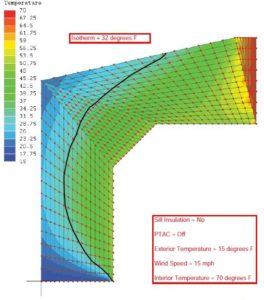 Existing condition |
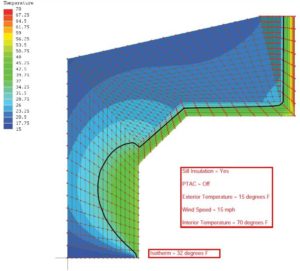 Proposed condition |
We then created a series of simulations in which we insulated the interior faces of the concrete so as to attempt to create the thermal break required to prevent the wholesale loss of building heat through the concrete sill. The results of these simulations predict that 1 inch of polyisocyanurate insulation on the interior face of the concrete sill will prevent melting on the sill in all conditions except those which also do not allow the snow melt to refreeze on the concrete.
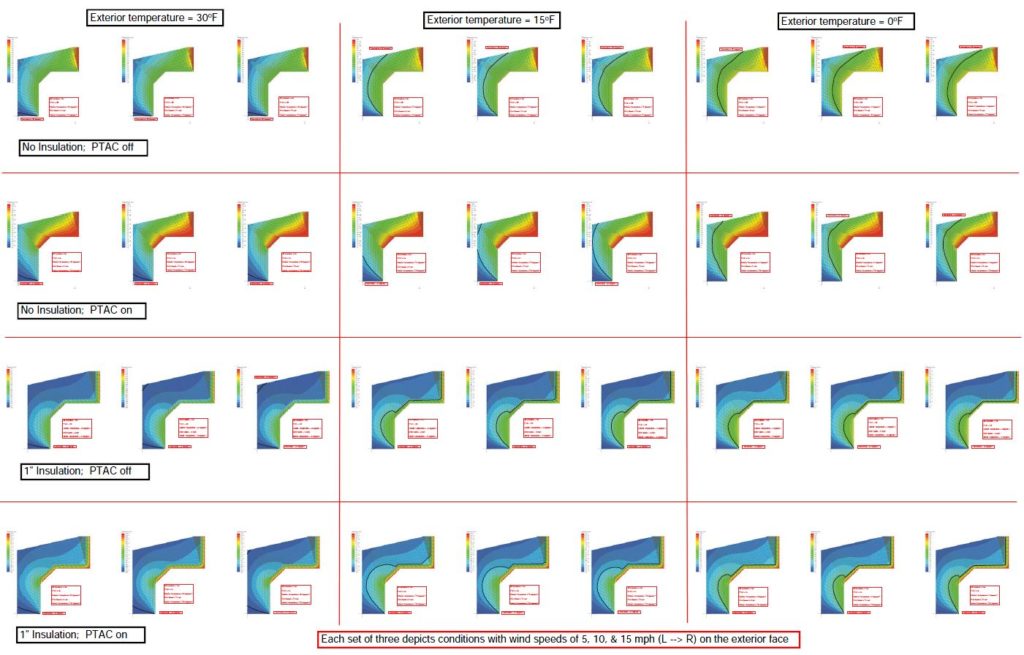
Over the remaining winter months, we have found that this condition seemed to be limited to larger snow events. We had several smaller snow falls (less than 4 inches at a time) and it seems that there is a critical mass of snow which is required to create the pieces of ice that are large enough to separate from the building. This critical mass has not been reached since that snow storm in mid-January but considering that we, in Syracuse, routinely win the Golden Snowball award for largest snowfall total during the winter months, we can be assured that we will typically get at least one storm capable of creating the conditions to cause this occurrence each year. The implementation of the findings of this analysis is yet to be completed and will be the topic of ongoing discussion with the client.
So what is the moral of this story? Thermal energy is a slippery devil. It finds unexpected paths and causes unexpected consequences. Thermal shorts in all of their forms can be a significant building performance and energy consumption issue. These issues impact not only the long term performance of the building itself, but the people who use the building day-in-and-day-out. This case study serves to highlight the usefulness of a relatively straight-forward Finite Element Analysis steady state thermal model in helping to determine the causes of a given condition as well as helping to identify what recommendations we can make in order to best address them.
N.K. BHANDARI is pleased to announce it has recently received the Federal Aviation Administration (FAA) Certificate of Waiver or Authorization (COA) and a Section 333 Grant of Exemption allowing the firm complete use of Unmanned Aerial Vehicles (UAV’s) for commercial use. This added capability allows NKB to provide an expanded set of services to our clients while also ensuring greater safety for the public, our clients, and our employees.
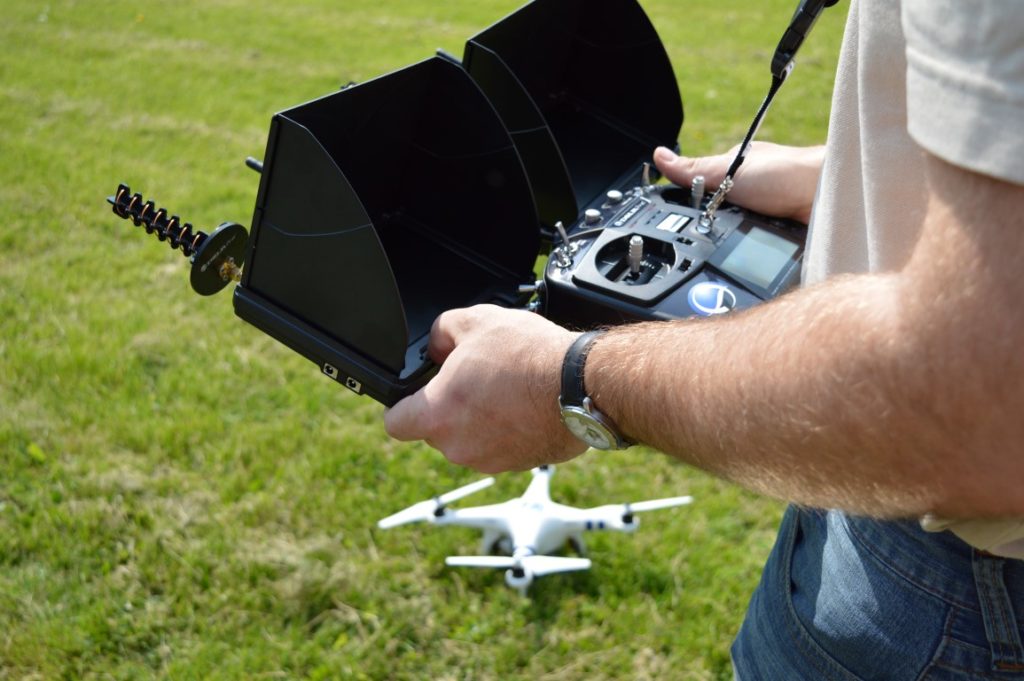
Through the use of our UAV technology, we are able to perform visual inspections of various types for structures including building facades, roofs, towers, bridges in both high definition still images, and 4K video in both the visual and infrared spectrums. Utilizing our DJI Phantom quad-copter UAV and automatic waypoint navigation, we are also able to provide terrain mapping services through photogrammetry. These technologies provide us with a set of files which can be utilized in our design platform software to create existing condition drawings and to obtain a topographical representation of any property with greater ease than was previously possible.
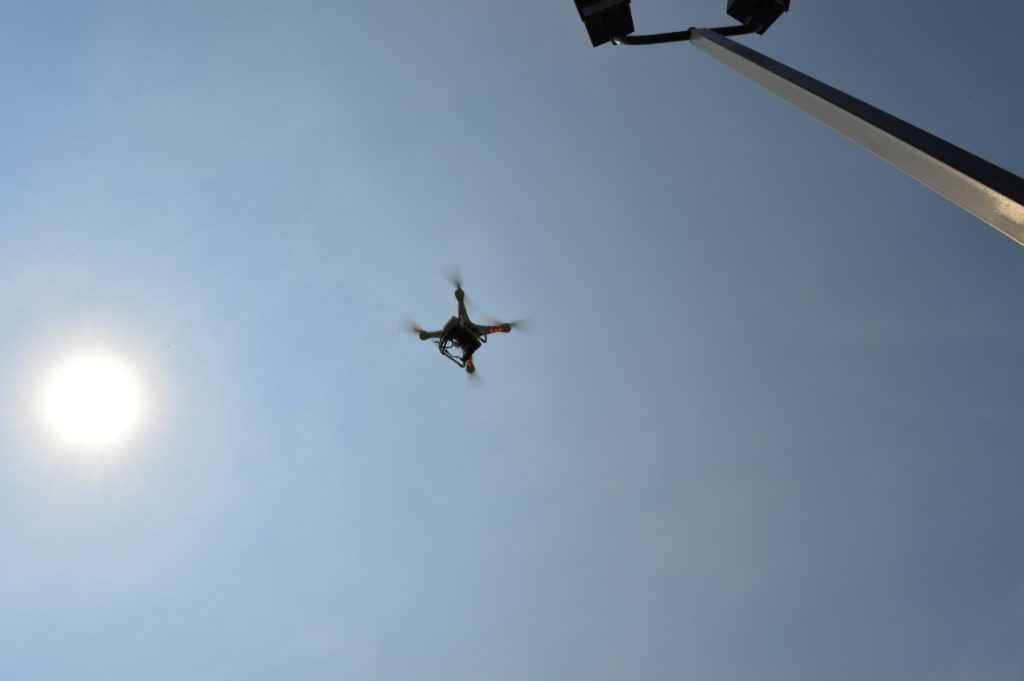
At N.K. BHANDARI, we embrace the use of technology to deliver a higher level of service as Architects and Engineers. By welcoming this technology, we are positioning ourselves at the leading edge of the design community. Through compliance with current FAA regulations relating to the usage of UAV’s we are able to provide a heightened level of peace of mind for our clients. All of our clients know that NKB not only works within the existing regulatory framework, but we also maintain all required insurances and operator training to ensure the highest level of client, employee, operator, and most importantly, public safety during our UAV operations.
NKB is excited to continue to lead by example by embracing and utilizing leading edge technology such as unmanned aerial vehicles with visual and infrared sensors to deliver unique results through unrivaled service.
N.K. BHANDARI is pleased to announce that it is the recipient of the 2016 Small Business Administration Excellence Award as nominated by the Onondaga Small Business Development Center. All of us at NKB are both humbled and honored by this recognition from the SBA. Honored because of who we are as a firm and what we have accomplished. At the same time we are humbled, because there are so many who should receive this honor with us.
There are so many we are fortunate enough to work with day-in-and-day-out that should be recognized more than us. These team members include every one of our clients, our design team sub-consultants, our business partners, the Small Business Development Center, the Small Business Administration, the former leadership of the firm (Narindar Bhandari and Jim Resig), and every employee of N.K. BHANDARI.
To all of the organizations and individuals who we are fortunate enough to call part of the NKB team, we extend our heart-felt thanks and expression of gratitude for honoring us with your gift, talents, and abilities in support of the firm. Thank you.
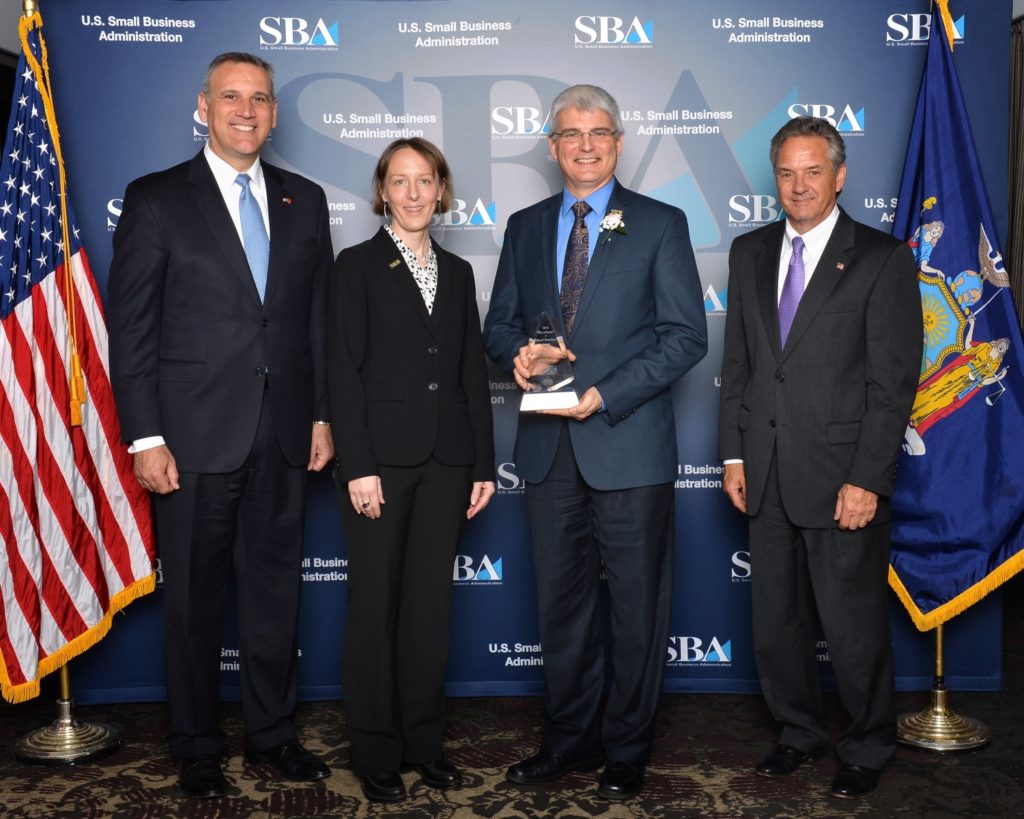
Photo from the Small Business Excellence Awards luncheon on May 6, 2016. From left to right: James Conroy, NYBDC | Karen Livingston, NY SBDC Onondaga | Chris Resig, N.K. BHANDARI, Architecture & Engineering, P.C. | Bernard J. Paprocki, SBA
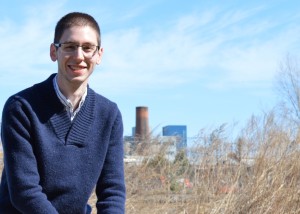
Scott Girouard – Spring Intern 2016
The opportunity to work simultaneously alongside architects and engineers was something I knew I wanted as I entered Syracuse University. I enjoyed seeing the two disciplines build off one another in a responsive manner.
For this reason, I chose to major in Civil Engineering and minor in Architecture. This unique, yet practical degree combination further interested me in how closely the two disciplines could function with respect to one another.
An opportunity to work collaboratively or simultaneously with engineers and architects had managed to elude me even as I entered my senior year. Unsuccessful previous attempts included working on a student architectural competition team, a design-build project, and inquiring about research pertaining to engineering and architecture collaboration efforts.
My internship at NKB came as I shifted my focus to design opportunities outside of SU. Upon my first glimpse of the NKB office I knew I was in the right place. The mostly open space allows me to easily ask engineers and architects any questions I may have.
What I did not know going into NKB was the range of exciting building types that I would soon be exposed to. NKB’s varied project types have allowed me to finally put my engineering and architecture education into practice. Whether it be through working on proposals, doing structural analysis, or working on Revit models, I am always learning something new.
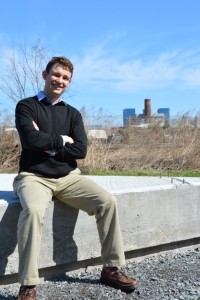
Jackson Honis – Spring Intern 2016
The project experience at NKB has already paid off in both my engineering and architecture coursework. My exposure to varied structural systems at NKB has allowed me to understand the reasoning for different building systems. In return this has allowed me to approach my structural steel senior design project with confidence.
The dynamic environment at NKB also means that I can regularly practice and build on my architectural knowledge. The opportunity to work on real projects has provided me with a new means to practice my Revit skills and technical building knowledge.
The idea of gaining professional practice in a supportive and inspiring environment is one that I could not recommend more highly to students like myself. The exposure to real building projects at NKB leaves me excited to learn more about the fields of engineering and architecture.
-Scott Girouard
![By Orietta.sberla (Own work) [CC BY-SA 3.0 (http://creativecommons.org/licenses/by-sa/3.0)], via Wikimedia Commons](https://upload.wikimedia.org/wikipedia/commons/7/7a/Ethics049webIV.jpg) One of the current buzz words in the business world is “business ethics” or “corporate ethics”. My assertion is that there is no such thing as business ethics or corporate ethics. The term business ethics implies that there are ethics in the business world and ethics outside the business world, assuming that people act one way at work and a different way at home. This is nonsense. When it comes to ethics, a person or organization either has them or they don’t. It is not compartmentalized into different portions of their corporate or personal lives. There are no business ethics, only ethics. These ethics are personified by the Integrity of the individuals who form the business in which they work day-in-and-day-out.
One of the current buzz words in the business world is “business ethics” or “corporate ethics”. My assertion is that there is no such thing as business ethics or corporate ethics. The term business ethics implies that there are ethics in the business world and ethics outside the business world, assuming that people act one way at work and a different way at home. This is nonsense. When it comes to ethics, a person or organization either has them or they don’t. It is not compartmentalized into different portions of their corporate or personal lives. There are no business ethics, only ethics. These ethics are personified by the Integrity of the individuals who form the business in which they work day-in-and-day-out.
The character trait of Integrity is where the essence of ethics can be found. While I do not disagree with the Merriam-Webster Dictionary definition of Integrity, which can be summarized as a quality that is incorruptible, sound, or complete; I do not believe this definition goes far enough. Integrity is inseparable from the very character of the individuals who comprise every business with no regard for type. Integrity is not a quality that someone has; it is a quality that someone is. Integrity is the very nature of who we are and what we do day-in-and-day-out, whether it is at work or home. Integrity is not a marketing campaign or a catchy slogan meant to garner comfort from our clients, stakeholders, or strategic partners; it is the essence of who we are. I believe Integrity is exemplified in the following ways:
Integrity is being Trustworthy.
Integrity demands a trustworthiness in all that we do. Our efforts are to result in dependable, reliable processes and outcomes. When Integrity is exemplified, consistent results are created produced and delivered. Integrity creates strength and structure in the individual and in the firm.
Integrity is having Open and Honest dialog.
Integrity necessitates the need for open and honest discussions in every facet of our day. Our intentions must be clear; confusing situations are removed through transparent exploration together. Integrity gives rise to the highest level of collaboration which unites all stakeholders in the same process. Integrity creates kinship and empathy in the individual and in the firm.
Integrity is being Candid, Authentic and Straightforward.
Integrity fosters the highest level of listening to and understanding of others; prompting honest communication without presumption. It is following through with promised intention, which builds confidence in everyone you come in contact with. Integrity creates mutual trust and loyalty in the individual and in the firm.
The very fabric of who we are as individuals becomes the essence of the organization in which we work every day. I am sorry, “business ethics” is a misnomer; it is simply ethics; it is our Integrity. A supremely simple concept, yet the very corner stone of who each of us is in our personal and corporate lives.
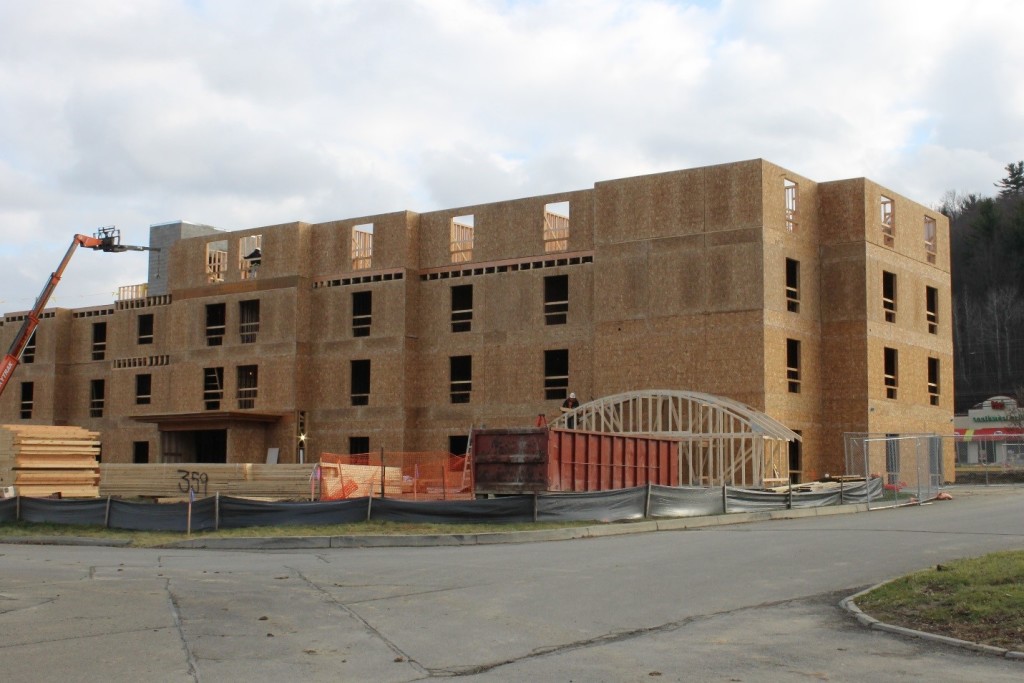 NK BHANDARI recently completed the structural engineering for a new 4 story hotel in the Southern Tier region of New York. The hospitality market is very competitive and initial cost can be the deciding factor for long-term viability of a hotel development project. For this building, a system of wood bearing walls and open-web wood floor trusses was selected. The wood systems have a lower initial cost than other options and the open webs of the floor members allow both the structure and the mechanicals to occupy the interstitial space thereby reducing the floor to floor elevations and the overall height of the building.
NK BHANDARI recently completed the structural engineering for a new 4 story hotel in the Southern Tier region of New York. The hospitality market is very competitive and initial cost can be the deciding factor for long-term viability of a hotel development project. For this building, a system of wood bearing walls and open-web wood floor trusses was selected. The wood systems have a lower initial cost than other options and the open webs of the floor members allow both the structure and the mechanicals to occupy the interstitial space thereby reducing the floor to floor elevations and the overall height of the building.
Weather can be a serious hindrance to the construction industry in this region of New York – especially in the late fall and early winter, so the contractor elected to further optimize the construction by panelizing the walls. With a panelized system, the walls are all constructed in the controlled environment of an offsite factory then shipped in 10 to 12 foot sections and erected on site. This allows for the building to quickly get built and enclosed. The longer duration of the field “stick-built” method is substantially reduced, and the length of time the wood members are exposed to the elements is therefore also reduced which helps eliminate delaminated floor sheathing issues often associated with traditional wood construction.
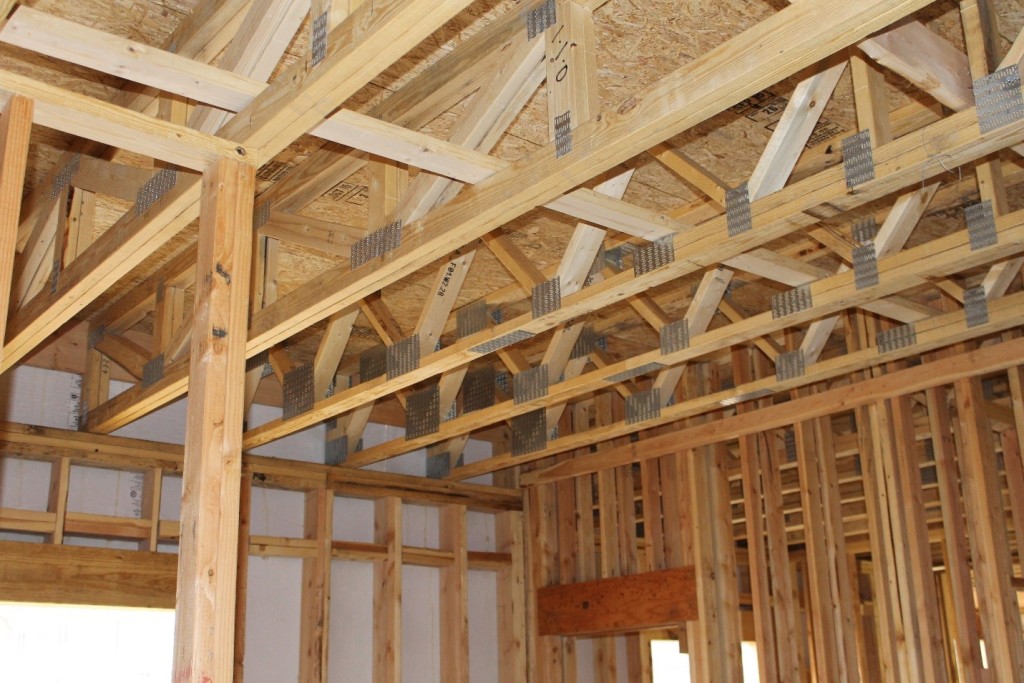 The economy of metal-plate-connected wood trussed roofs is widely recognized, and are often used even if the structure is concrete block. For a wood building like this, wood trusses are the go-to solution. This building explores the versatility of the system with traditional gables and custom round-arched dormers integrated to produce the architectural aesthetic required.
The economy of metal-plate-connected wood trussed roofs is widely recognized, and are often used even if the structure is concrete block. For a wood building like this, wood trusses are the go-to solution. This building explores the versatility of the system with traditional gables and custom round-arched dormers integrated to produce the architectural aesthetic required.
A similar approach could be achieved with cold formed steel bearing walls and trusses if a non-combustible system is desired.
 The word design can be defined in many ways, but I like one of the Merriam-Webster’s definitions best where design is described as “the arrangement of elements or details in a product or
The word design can be defined in many ways, but I like one of the Merriam-Webster’s definitions best where design is described as “the arrangement of elements or details in a product or
work of art.” So in other words, it is both how the colors in a painting make you feel, but also how the frame around that painting is constructed and holds that piece of art to the wall. But when it relates to architecture and the space around you where you live and work, what does design really mean?
Design in architecture can mean things like “the spatial relations of the void and the solid space,” “a harmonic juxtaposition of materiality,” or it can be as simple as “the bathrooms are centrally located for the convenience of everyone.” Making spaces and places that are
beautiful and artistic are an important part of architectural design, but the seemingly simply details of where the restrooms are located, and how many cabinets you have can sometimes be even more important. When it comes to making sure the space around you helps your life and work function better, having a design team beside you that asks the right questions, and considers the easily overlookable functional tasks is how you create a space that works for you.
That’s right, your space work for you. You did know that the role of the building around you is to make your life better and easier right? That is what design means to me; design is functionality that also happens to be attractive. The process of design is listening to you to find out what it is that you need to be successful, and then transforming that into a physical space that helps you be successful. This can be as simple as making sure your new office furniture is arranged correctly, or it can mean making sure your new building is tall enough to accept that new very expensive piece of equipment you just bought. Either way the design of how it WORKS matters just as much (or more) than how it looks. Don’t you want your space designed to work for you AND look the way you want it to?
If you are reading this you might be asking yourself, “Self, how do I capture meaningful data with my infrared camera?” Or, “Self, do I know enough of the basics of thermography in order to perform a thermal analysis?” Or, “Self, why in the world are you speaking in the third person?” In the world of thermography there are many considerations that must be made when taking and analyzing the images captured but there is one piece of science that is most important in obtaining meaningful results. This is especially true if your goal is to take even remotely accurate temperature readings using your IR camera. This little nugget of thermographic gold is:
Energy Absorbed + Energy Reflected + Energy Transmitted = Total Energy Observed from a Body
OR
α + ρ + τ = 1
where:
α= Ratio of Energy Absorbed by a Body to Total Energy Observed from a Body
ρ = Ratio of Energy Reflected by a Body to Total Energy Observed from a Body
τ = Ratio of Energy Transmitted by a Body to Total Energy Observed from a Body
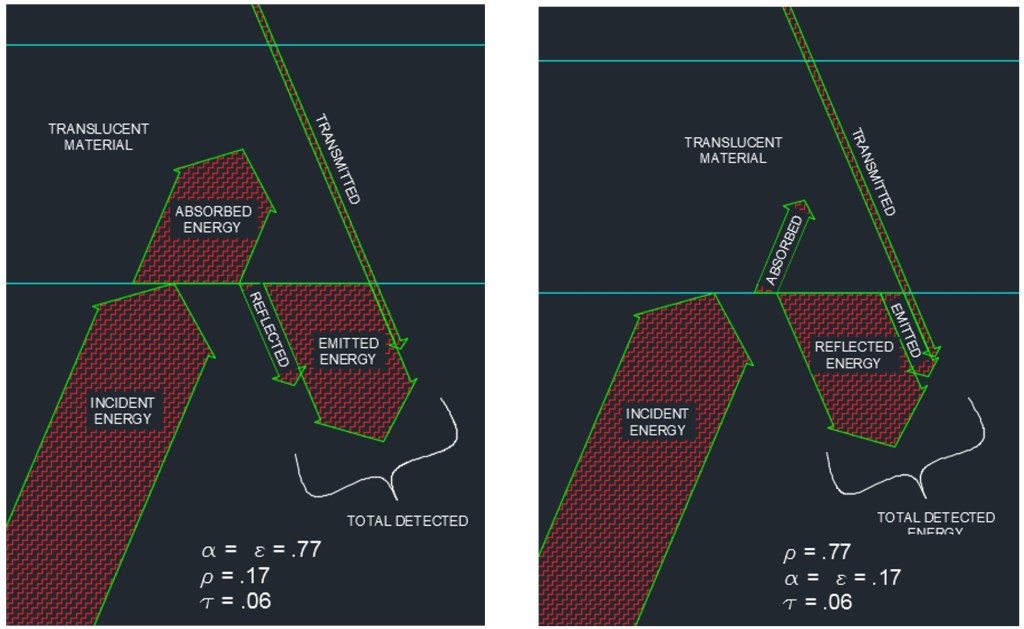
Translucent Material, Highly Absorptive vs. Translucent Material, Highly Reflective
Bear with me while I lay out a couple of necessary concepts. For most opaque materials, the transmitted energy is equal to zero. Even my children can grasp this concept when I explain to them that we don’t typically feel the warmth of the sun directly while standing in the shade. We feel the temperature of the air around us. The infrared energy is not able to penetrate most opaque objects so this concept is somewhat intuitive. The implication of this fact is that for most objects which appear in an IR image, the transmittance can be taken to be zero. Additionally, in the mid-1800’s, Gustav Kirchoff gave us a relationship that came to be known as Kirchoff’s Law of Thermal Radiation. I will significantly simplify Kirchoff by telling you that his Law of Thermal Radiation states that, for a body at thermodynamic equilibrium (constant temperature), the absorptivity is equal to the emissivity (α = ε).

Pasta Sauce on Stove – Delicious!
Simply put, whatever thermal energy the object absorbs, it also radiates that same amount back to the atmosphere. If the absorptivity and emissivity were different the object would be in the midst of a temperature change. Think of a pot of tomato sauce with the lid on left to simmer on a stove. The temperature of the pot is hot enough to burn you if you touch it but it has reached a constant temperature and is no longer getting any hotter. The energy absorbed from the burner by the pot (absorptivity) is equal to the energy emitted to the atmosphere by the pot (emissivity).
So, we can simplify and restate our previously identified relationship to be:
ε + ρ =1
where:
ε = Ratio of Energy Emitted by a Body to Total Energy Observed from a Body
ρ = Ratio of Energy Reflected by a Body to Total Energy Observed from a Body
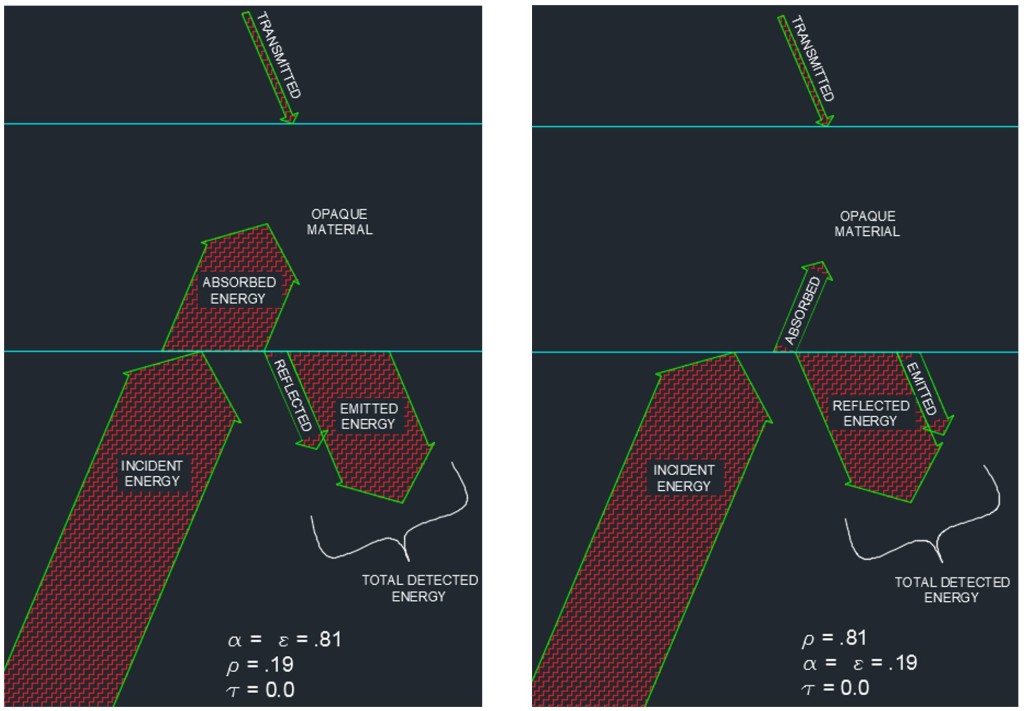
Opaque Material, Highly Absorptive vs. Opaque Material, Highly Reflective
How about a couple of real life images to illustrate this?We can now see an inverse relationship between the thermal reflectance and the thermal emissivity of an object. The more reflective something is, less of the energy that we see come from its surface is actually emitted by that object.
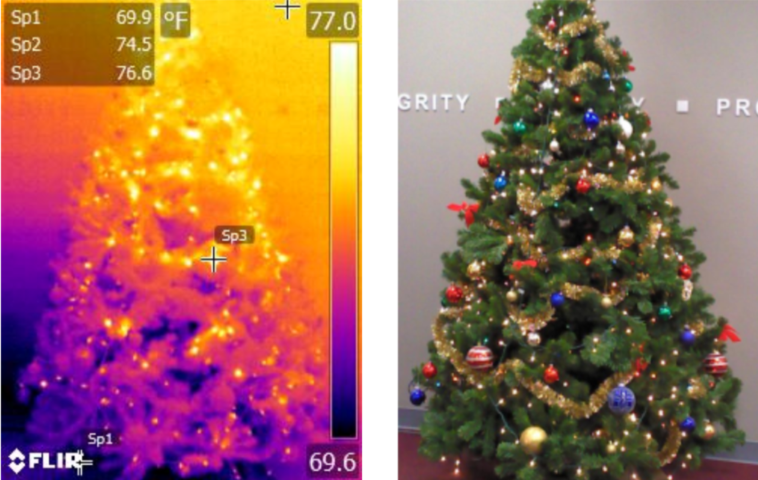
IR & Visual Images of Christmas Tree
In the image above we see a traditional Christmas tree and the corresponding thermal image. In this image we can clearly see a thermal gradient from floor to ceiling as is to be expected. We also, unsurprisingly, see bright spots where the lights are emitting additional heat being picked up by the IR camera. This is a good example of looking at the thermal energy being emitted by what are mostly opaque, highly emissive objects. Now let’s take a closer look…
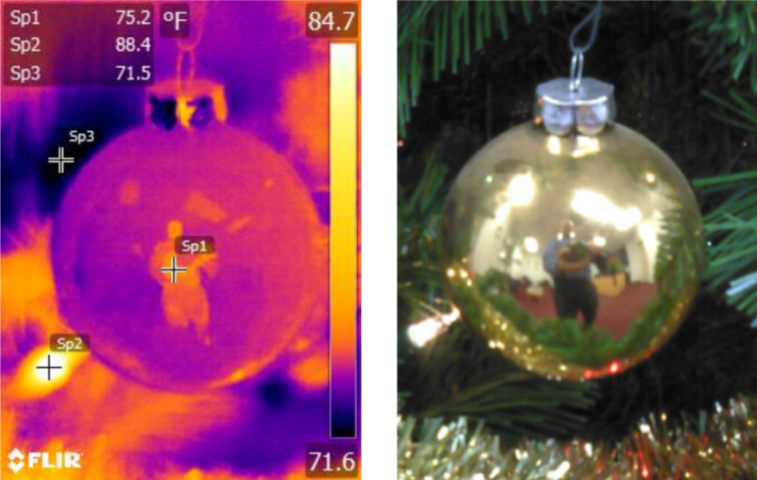
IR and Visual Images of Ornament
In the above image we are looking at one of the ornaments on the tree shown in the previous image. We can see that it is highly reflective in the visual spectrum. When we look at the IR image, sure enough, there is a reflection of the person taking the picture here as well. The temperature shown on the ornament is going to be rather inaccurate because it is actually measuring a portion of the photographer’s heat energy. This image demonstrates the difficulty we can experience when taking IR images without regard to the nature of the object we are documenting. We must have an understanding of what the material and finish is of the object we are analyzing in the IR images.
What is the bottom line to all of this? Just because your IR camera says that the temperature is 106.5oF, doesn’t mean that it is. When we look at an object with a highly reflective surface we may be picking up a portion of the IR energy of other sources in the area. If we are looking at something that may be translucent to IR wavelengths, we may be seeing the IR energy of objects behind what we are attempting to measure. In order to obtain meaningful results from our IR images we must account for these factors (and many, many others – but those are for later posts!). Be sure to stop by often to stay up to date on our series of building science posts. Some of our future topics will include: The Primary Concerns of Thermal Image Capture – FORD, Accounting for Environment Interference in Thermal Images, Envelope U-value and Moisture Migration, The Wonder of Thermal Hysteresis, and much, much more! If there are other topics that you would like to see us cover, feel free to contact us and let us know.
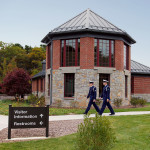 When in need of a licensed professional, you seek out those on whom you can implicitly rely, that have the requisite experience and expertise, as well as references, to help you resolve your current challenge. Looking for a “subject matter” expert means searching for someone who is at the top of their game. Through a short series of posts, I’ll share some of my ideas on what it’s like being a professional, and how the concepts of being “Thorough, Accountable and Reliable” factor into what professionalism can and should be.
When in need of a licensed professional, you seek out those on whom you can implicitly rely, that have the requisite experience and expertise, as well as references, to help you resolve your current challenge. Looking for a “subject matter” expert means searching for someone who is at the top of their game. Through a short series of posts, I’ll share some of my ideas on what it’s like being a professional, and how the concepts of being “Thorough, Accountable and Reliable” factor into what professionalism can and should be.
- Observe & Learn – Knowing what the priorities are and understanding differences between time-wasting procedures and truly important work is part of what makes you become thorough. Committing the requisite time needed right from the start may seem laborious or counterproductive, but it’s not until you understand this concept that your foundation for thoroughness will become strong.
- Technology – Smartphone apps, trending business techniques, and computer programs are frequently developed promising better organization and productivity. However, our reliance on them can lead to losing our focus, giving us a false sense of being productive. How often have we been more impressed with obtaining a newer or updated app or software tool than actually rolling up our sleeves and tackling the issue we were hired to resolve?
- Be Open to Change – (and to changing yourself) It’s okay to pursue known paths for your knowledge-base; but some of the best learned things happen by pushing yourself to figure out what you’re passionate about, and shifting your career closer to those things.
- Become a Learner – There are so many professionals I know who have just stop trying new things. Or those that preach about how things have always been done for the last umpteen years and don’t need to change. Broaden your horizons.
- Build a Strong Network – Congrats to you if you have a robust network within your firm; but you’d do well to also have a large, diverse and strong network outside of your firm. There’s always something more urgent to do than developing this; but having another outlet to tap into when questions arise that you don’t know the answer is a tremendous asset.
- Checks and Balances – Thoroughness involves others – like having a second or third set of eyes review your information. Also, consider how other team members may be affected by the decisions you will be making. Gathering all of this input will provide much clearer information with which to make intelligent decisions.
- Keep Skills Current – Learn to expand your vocabulary of skills, keep marketing abilities up-to-date by volunteering time at a non-profit. Recognize, measure and identify what technical expertise you are lacking and discover simple ways to acquire them.
- Confront Mistakes – We all make mistakes; no one is perfect. We want to do our very best, but everyone falls short at times. These are just the facts of life and we should understand and be okay with that. What’s more important is how you deal with your mistakes. Be upfront and address problems right away. Be flexible and nimble enough to know what you don’t know and admit it. Your clients would rather hear honesty than excuses.
- And finally, Take Responsibility – Own up to mistakes and make them right. Then, figure out what happened so it can be prevented in the future. This idea of responsibility, or accountability, is something that will be discussed in the next post of this series.
The following are words of wisdom my father-in-law instilled in me: “A Job Well Begun is a Job Half Done”. Spending the requisite time being thorough from the start provides you more time during your productivity. If you know you’ve conducted the right research and asked the right questions, then you won’t flounder during the actual work or have to circle back to re-do what you’ve already done, because you didn’t have all the facts. Your thoroughness, and thus your professionalism, imbues a level of trust and confidence in others. Like an attorney trying a case, you must meticulously research and gather all the evidence needed to make your argument – before going to court and winning!
I am an architect. I have risen through the ranks, worked for various firms, own my firm and through my career have developed my own parameter for quality in the field of architecture and that is: Quality is defined by the client not self-proclaimed by the design professional. When most people consider Quality, they think of a product that is without defect or a product that serves its intended purpose. In my career, Quality is far more than that, it is also the service perceived by the client.
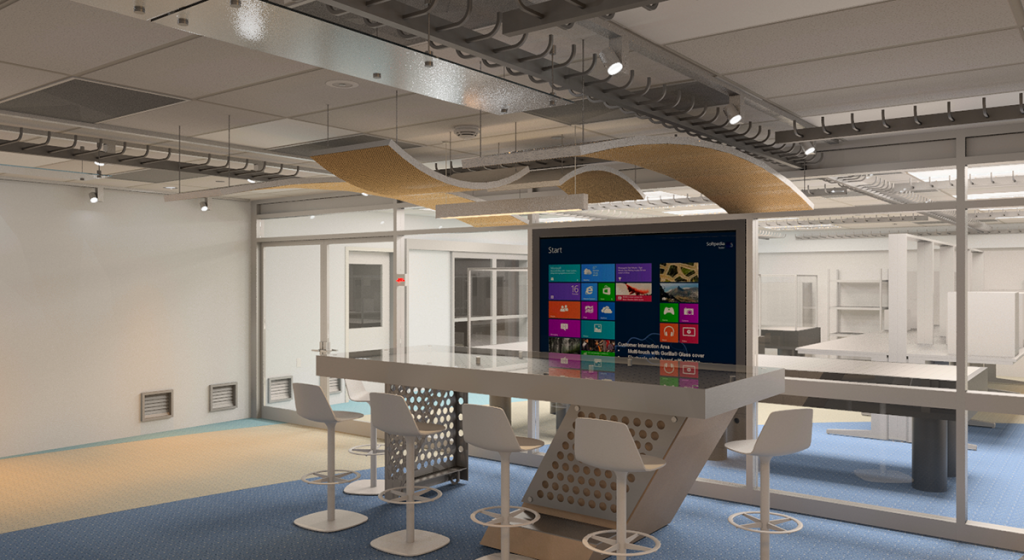
Therefore, I have come to the conclusion that Quality as defined by service cannot be attained unless each of these factors are achieved in the client’s eyes.
- Collaboration through meaningful participation from all project team members and stakeholders (both client & design professional).
- Stability by satisfying the demands of scope, schedule, and budget and keeping them in balance without one becoming excessive to the detriment of the others.
- Creativity: The design process brings into existence what was not yet known. It takes real creativity to insert a not-yet-formulated design concept into the design process without disrupting a stable and collaborative project environment. For me, the creative process of inserting what is not yet designed into the design process is the true worth of a design professional; requiring careful attention to detail and the utmost of service for the client.
When Collaboration, Stability, and Creativity are achieved to the client’s satisfaction, then and only then, is Quality achieved.

